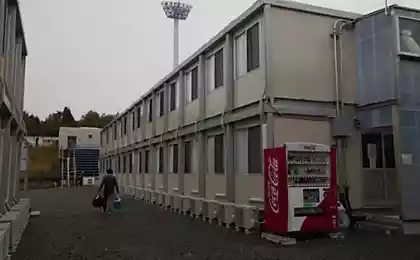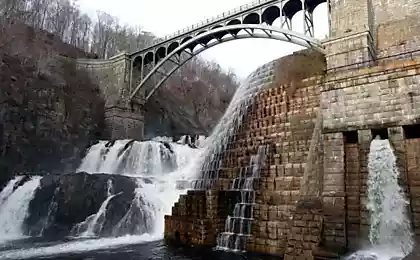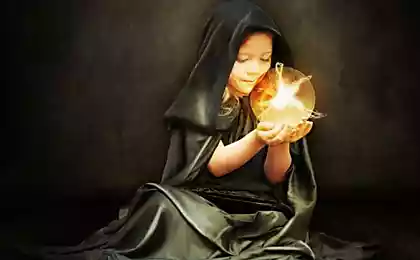495
The Welsh project tidal lagoon power plant could make a revolution in British energy
The next few weeks, supporters of the ambitious project will explore the possible transformation of the UK electricity supply, if approved the construction of tidal lagoons to generate electricity. The green light can see a number of projects tidal lagoon power plant, worth 15 billion pounds, which should be built on the coast of the UK.

A tidal lagoon generates electricity from the natural rise and fall of the water level. The rising flow of water driven turbines located along the levees for miles and miles. The mass of water is constrained by videograde wall (because the necessary height difference at low tide), the water then passing through the turbines again produces thousands of megawatts of power.

The project will allow for construction in Swansea Bay in the next few years – but only if you get odobrenie from government testing of the technology, tidal lagoon, under the leadership of former energy Minister Charles Hendry, who is scheduled to give its recommendation in the beginning of next month.
Mark Shorrock, head of the project "Tidal Lagoon" and curator of the lagoon power plant in Swansea, said that the technology could be an important source bezplatni of electricity for the UK.
"In addition, the money for the construction of the tidal lagoon will come from British investors, as valuable knowledge and technologies that we develop can be sold around the world," he said. Tidal lagoons can also provide most of the energy needed to fill the projected shortage of energy in the UK, which would entail phasing out coal plants and old nuclear reactors vtechenie the next decade, he added.

The six main projects were designed for construction: prototype in Swansea Bay; and then a full-sized lagoon power stations in Cardiff, Newport, Colwyn Bay, Bridgewater Bay and East Cumbria. "The key moment in the creation of a tidal lagoon is that their power generation is not dependent on the vagaries of the weather. It's predictable. We know exactly when each tide for many years to come. In addition, Lagoons will be constructed for approximately 120 years, "" said Shorrock.
A prototype of the Swansea Bay have been developed for 1.3 billion pounds, to produce 350 MW of power — enough to supply 150,000 homes with electricity — and can be commissioned by 2019. Approximately 11 square kilometers of the Bay must be surrounded by a 9 km long wall. On the walls will be built bike paths, and inside the lagoon will create a centre for sailing and Canoeing.
The tides must be filled with water of the lagoon through 16 turbines, generating electricity. Then once the tide has passed, the remaining water should be released back from the lagoon through the turbines in the opposite direction to produce additional electricity. Shorrock claims that the lagoon could generate electricity for approximately 14 hours a day.

Electricity from the Swansea Bay would cost approximately 89,90 lb/MWh compared to a price of £ 92,50/MWh projected for electricity from nuclear installations Hinkley point (nuclear power station in Somerset). “However, when we widen the scope to the lagoon in Cardiff — which will have a generating capacity of 10 times more than Swansea – we will be able to produce energy for 65 lb/MWh,” said Shorrock.

The cost of construction of the power plant lagoon Cardiff is 9 billion pounds, which will contain 65 square kilometers of water within the 20-kilometer wall. Its capacity of 3,000 MW of electricity – compared to 3200 MW from Hinkley point.
Request for the permission of the Cardiff lagoon design should be done by 2018 with the aim of creating support infrastructure for the components of the lagoon in the UK.
Mark Robbins, member of the RSPB (Royal society for the protection of birds) shared his thoughts — “Tidal lagoon Swansea can be very useful, but before we scale up we'll have to see how the first prototype of the affect the movement of silt at the mouth of the river, shatter bird population and learn the impact on fish stocks. This brand new technology that will be built in a very complex natural object – the Severn estuary. We need to be very careful on your way”. published
Source: www.theguardian.com/environment/2016/oct/08/tidal-power-swansea-bay-lagoon

A tidal lagoon generates electricity from the natural rise and fall of the water level. The rising flow of water driven turbines located along the levees for miles and miles. The mass of water is constrained by videograde wall (because the necessary height difference at low tide), the water then passing through the turbines again produces thousands of megawatts of power.

The project will allow for construction in Swansea Bay in the next few years – but only if you get odobrenie from government testing of the technology, tidal lagoon, under the leadership of former energy Minister Charles Hendry, who is scheduled to give its recommendation in the beginning of next month.
Mark Shorrock, head of the project "Tidal Lagoon" and curator of the lagoon power plant in Swansea, said that the technology could be an important source bezplatni of electricity for the UK.
"In addition, the money for the construction of the tidal lagoon will come from British investors, as valuable knowledge and technologies that we develop can be sold around the world," he said. Tidal lagoons can also provide most of the energy needed to fill the projected shortage of energy in the UK, which would entail phasing out coal plants and old nuclear reactors vtechenie the next decade, he added.

The six main projects were designed for construction: prototype in Swansea Bay; and then a full-sized lagoon power stations in Cardiff, Newport, Colwyn Bay, Bridgewater Bay and East Cumbria. "The key moment in the creation of a tidal lagoon is that their power generation is not dependent on the vagaries of the weather. It's predictable. We know exactly when each tide for many years to come. In addition, Lagoons will be constructed for approximately 120 years, "" said Shorrock.
A prototype of the Swansea Bay have been developed for 1.3 billion pounds, to produce 350 MW of power — enough to supply 150,000 homes with electricity — and can be commissioned by 2019. Approximately 11 square kilometers of the Bay must be surrounded by a 9 km long wall. On the walls will be built bike paths, and inside the lagoon will create a centre for sailing and Canoeing.
The tides must be filled with water of the lagoon through 16 turbines, generating electricity. Then once the tide has passed, the remaining water should be released back from the lagoon through the turbines in the opposite direction to produce additional electricity. Shorrock claims that the lagoon could generate electricity for approximately 14 hours a day.

Electricity from the Swansea Bay would cost approximately 89,90 lb/MWh compared to a price of £ 92,50/MWh projected for electricity from nuclear installations Hinkley point (nuclear power station in Somerset). “However, when we widen the scope to the lagoon in Cardiff — which will have a generating capacity of 10 times more than Swansea – we will be able to produce energy for 65 lb/MWh,” said Shorrock.

The cost of construction of the power plant lagoon Cardiff is 9 billion pounds, which will contain 65 square kilometers of water within the 20-kilometer wall. Its capacity of 3,000 MW of electricity – compared to 3200 MW from Hinkley point.
Request for the permission of the Cardiff lagoon design should be done by 2018 with the aim of creating support infrastructure for the components of the lagoon in the UK.
Mark Robbins, member of the RSPB (Royal society for the protection of birds) shared his thoughts — “Tidal lagoon Swansea can be very useful, but before we scale up we'll have to see how the first prototype of the affect the movement of silt at the mouth of the river, shatter bird population and learn the impact on fish stocks. This brand new technology that will be built in a very complex natural object – the Severn estuary. We need to be very careful on your way”. published
Source: www.theguardian.com/environment/2016/oct/08/tidal-power-swansea-bay-lagoon
They are so well suited to each other about Costs and Divorce
THE TRUTH ABOUT CANCER. The search for methods of treatment























